Exercise 11:
A drawbridge is 150 feet long when streched across a river. The two sections of the bridge can be rotated upward through an angle of ![]() .
.
If the water level is 15 feet below the closed bridge, what is the distance ![]() between the end of a section and the water level when the bridge is fully open?
between the end of a section and the water level when the bridge is fully open?
Approximaetely how far apart are the ends of the two sections when the bridge is fully opened per image?
Solution:
Distance AB is half the width of the bridge ![]()
The distance ![]()
![]()
This gives:![]()
![]()
![]()
That means:![]()
Now For distance ![]()
We can see that:![]()
But we can see that:![]()
![]()
![]()
![]()
Now back to ![]()
![]()
![]()
Exercise 12:
Verify the following identity:
![]()
Solution:
We have:
![]()
![]()
![]()
![]()
![]()
![]()
![]()
![]()
Finally:![]()
Exercise 13:
In the following figure we can note:![]()
![]()
The circle of center ![]() has a radius of
has a radius of ![]()
Calculate the value of ![]()
Calculate the distance ![]()
What relation can we get between ![]() ,
, ![]() and
and ![]() ?
?
If ![]() :
:
-What is the measure of ![]() ?
?
-Calculate Arcs ![]() ,
, ![]()
-what relationship can we get between ![]() ,
, ![]() ,
, ![]() ?
?
For ![]() :
:
Calculate values of ![]() and
and ![]()
Solution:
We have the right triangle ![]()
![]()
![]()
![]()
For ![]()
![]()
That yields:
![]()
This confirms our relation:![]()
Calculating angle ![]() :
:
Angles ![]() and
and ![]() are complementary angles:
are complementary angles:![]()
Central angle ![]()
![]() and
and ![]() are supplementary:
are supplementary:![]()
We can see that:
![]()
Calculating ![]()
![]()
This yields:![]()
![]()
![]()
We also have:
![]()
This gives:![]()
![]()
Exercise 14:
Given:
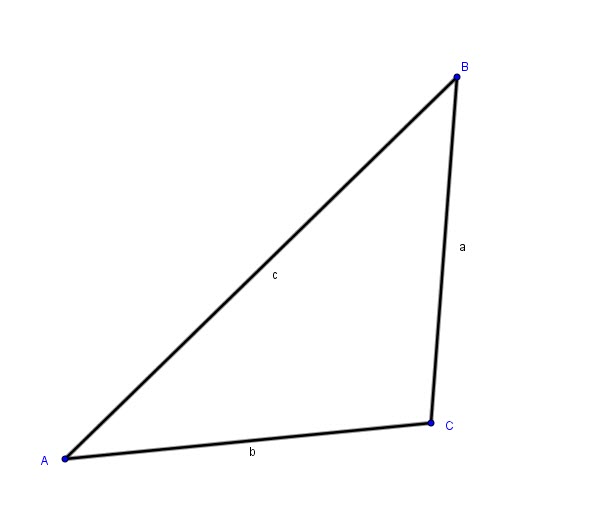
![]()
![]()
![]()
Find the other elements if the triangle is possible.
SOLUTION
ANGLES![]()
![]()
![]()
SIDES:![]()
![]()
![]()
We notice that side ![]() this means that
this means that ![]()
We can safely use the LAW OF SINES:
![]()
![]()
![]()
For side c:![]()
Answer:
ANGLES![]()
![]()
![]()
SIDES:![]()
![]()
![]()
We also verify that ![]() because
because ![]()
Exercise 15:
![]()
![]()
![]()
Find the other elements if the triangle is possible.
SOLUTION
[accordion hideSpeed=”300″ showSpeed=”400″]
[item title=”Click here to see the solution for Exercise 15 “]
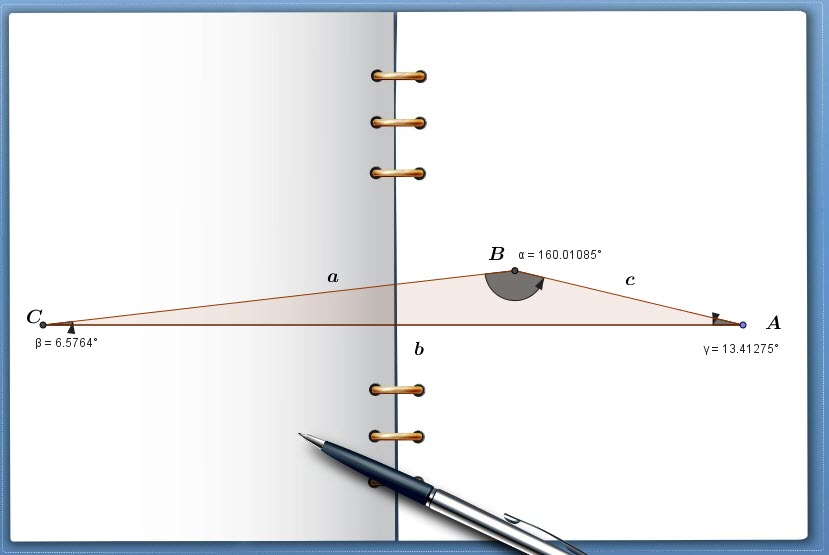
ANGLES
![]()
![]()
![]()
SIDES:![]()
![]()
![]()
We notice the the sum of the measures of ![]() and
and ![]() is only
is only ![]()
Let’s try to calculate:
![]()
![]()
![]()
Answer:
ANGLES![]()
![]()
![]()
SIDES:![]()
![]()
![]()
Exercise 16:
![]()
![]()
![]()
Find the other elements if the triangle is possible.
SOLUTION
ANGLES![]()
![]() C=?
C=?
SIDES:![]()
![]()
![]()
We notice that side ![]() this means that
this means that ![]()
But in this case we don’t know if one angle is obtuse. We use the law of cosines.
Side ![]()
![]()
![]()
For ![]()
![]()
![]()
Answer:
ANGLES![]()
![]()
![]()
SIDES:![]()
![]()
![]()
Exercise 17:
The following slide design is part of a water slide.
What is the total length of the shown slide having the 3 parts?
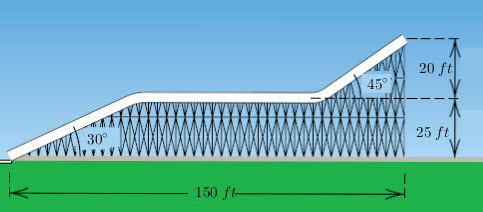
Solution:
The total distance here is the sum of the 2 hypothenuses and the horizontalpart between them.
Let ![]() be the 1st hypothenuse,
be the 1st hypothenuse, ![]() the horizontal part and
the horizontal part and ![]() the second hypothenuse.
the second hypothenuse.
For the ![]() angle:
angle:
![]()
![]()
![]()
Let the horizontal part below the angle ![]() be
be ![]()
![]()
![]()
![]()
For the ![]() angle:
angle:
![]()
![]()
![]()
Let the horizontal part below the angle ![]() be
be ![]()
Note that student can simply say that ![]() since the triangle is isosceles.
since the triangle is isosceles.![]()
![]()
![]()
The horizontal distance :![]()
The total Length ![]() :
:![]()
The total length of the slide is: ![]()
Exercise 18:
From point ![]() , the mountaintop is viewed with an angle of elevation of
, the mountaintop is viewed with an angle of elevation of ![]() .From point
.From point ![]() , located at a distance of
, located at a distance of ![]() miles due East from
miles due East from ![]() , the same mountaintop has an angle of elevation of
, the same mountaintop has an angle of elevation of ![]() .
.
verify fro figure that:![]()
What is the height of the mountain ![]() when
when ![]() ,
, ![]() and the distance
and the distance ![]() ?
?
Solution:
Let ![]() be the point at the base of the mountain.
be the point at the base of the mountain.
From the figure we can see that:![]()
The same way:
![]()
But from triangle OPQ:
![]()
![]()
![]()
This yields:

![]()

![]()
Let’s analyse the denominator:
(1) 
Back to the equation of ![]() :
:![]()
Finally:![]()
Plugging the given numbers:![]()
![]()
![]()
Exercise 19:
The observer of height ![]() stands on an incline at a distance
stands on an incline at a distance ![]() from the base of a building of height
from the base of a building of height ![]() , per figure. The angle of elevation from the observer to the top of the building is
, per figure. The angle of elevation from the observer to the top of the building is ![]() , and the incline makes an angle of
, and the incline makes an angle of ![]() with the horizontal.
with the horizontal.
What is the equation of ![]() using variables
using variables ![]() ,
, ![]() ,
, ![]() and
and ![]() ?
?
Using:
![]()
![]()
![]()
![]()
find the height of the building ![]() .
.
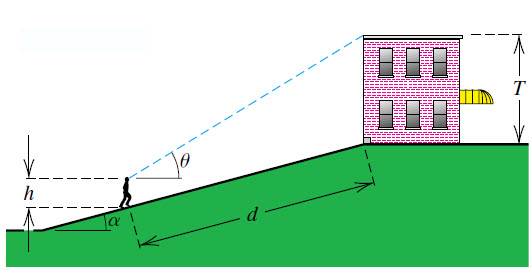
Solution:
Looking at the figure:
In triangle ![]() we can note that
we can note that ![]() , corresponding angles of the transversal.
, corresponding angles of the transversal.
![]()
We also have:![]()
In triangle HOI:
We can see that ![]()
Also:
![]()
![]()
But ![]() and
and ![]()
We get:![]()
Finally:
![]()
Using the values:
![]()
The height is:
![]()
[/item] [/accordion]
Exercise 20:
A ladder of ![]() long leans against the side of a building, and the angle between the ladder and the building is
long leans against the side of a building, and the angle between the ladder and the building is ![]() .
.
Calculate the distance ![]() from the bottom of the ladder
from the bottom of the ladder ![]() to the building(
to the building(![]() ).
).
The distance from the bottom of the ladder to the building is increased by ![]() . How far does the top of the ladder move down the building?
. How far does the top of the ladder move down the building?
Solution:
From the figure:![]()
This yields:![]()
![]()
![]()
From the figure we see that ![]()
![]()
![]()
![]()
From triangle ![]() we have two methods to find
we have two methods to find ![]()
We can just say that:
![]()
This gives:
![]()
![]()
![]()
Second method is the pythagorean theorem:
In triangle ![]() :
:![]()
At this stage we can calculate angle at ![]() or simply use the pythagorean theorem. We do both:
or simply use the pythagorean theorem. We do both:
![]()
![]()
![]()
Now ![]() :
:![]()
![]()
![]()
![]()
The second method shows:![]()
But ![]() from above.
from above.
This gives:![]()
Finally:
The ladder moves down by ![]()
Exercise 21:
Find the area of the following triangle in the figure:
Solution:
The sum of the angles is ![]() :
:
For ![]() :
:
![]()
![]()
![]()
We know that ![]()
That means:
![]()
We also know that The area can be:
![]()
We substitute ![]() :
:
![]()
![]()
![]()
Exercise 22:
A ladder leans against the side of a building, and the angle between the ladder and the building is ![]() .
.
After the top of the ladder was moved down the building by ![]() , the bottom of the ladder to the building was increased by
, the bottom of the ladder to the building was increased by ![]() .
.
What is the length of the ladder?
What angle is the new angle between the ladder and the building?
What is the distance from the bottom of the ladder to the building?
Solution:
From the figure:![]()
We also have:![]()
We can see from the figure:![]()
![]()
But from above we have:![]()
We get:![]()
![]()
![]()
![]()
![]()
![]()
![]()
The length of the ladder is:![]()
Finally :![]()
For the angle ![]() :
:
We know that:![]()
![]()
![]()
The distance ![]() is:
is:![]()
The new angle ![]() :
:![]()
![]()
Used six digits to reduce the loss of accuracy.![]()
This yields:![]()
Exercise 23:
Solve for ![]() when
when ![]()
![]()
Solution:
![]()
![]()
![]()
The base angle hase ![]() as
as ![]() value.
value.
We get two angles here:![]()
The solutions are:![]()
for ![]() we get
we get ![]()
![]()
for ![]() we get
we get ![]()
when ![]() :
:
Solutions:![]() and
and ![]()
See figure.
Exercise 24:
Express ![]() in terms of
in terms of ![]() only.
only.
Solution:
(2) 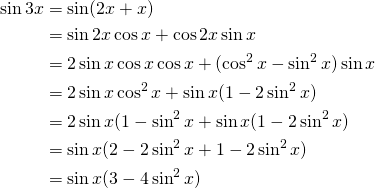
Finally:![]()
Exercise 25:
Verify:![]()
Solution:
We have:![]()
But we know that:
![]()
This yields:![]()
But:![]()


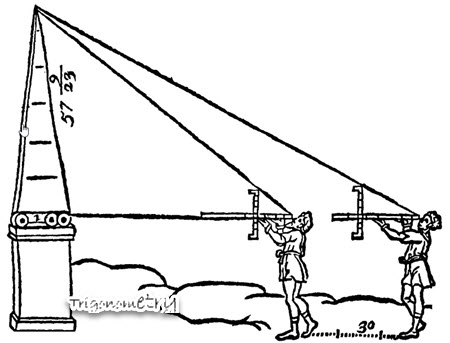
Be the first to comment